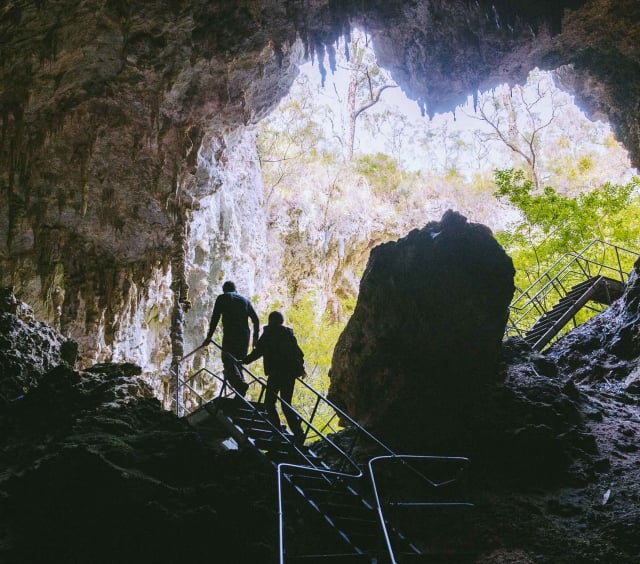
Mammoth Cave is one of the larger caves in the South-West with huge caverns and majestic formations. It was one of the first caves to be opened to tourists on a regular basis. This awe inspiring cave is a natural time capsule and home to ancient fossil remains of extinct animals. It is likely that it was once occupied by early Australians. A perennial stream flows through Mammoth Cave during winter and early spring. The stream has slowly eroded the limestone over the past eons creating huge caverns and large rock-piles. There are many cave formations including stalactites and stalagmites of extraordinary length and size, flowstones which resemble a karri forest and beautiful shawls.
Reports of the discovery of a cave in the vicinity of Mammoth Cave date back to 1895, but it is unlikely that exploration was undertaken at the time. Mammoth Cave was located by surveyor Mr Marmaduke Terry in September 1900, and explored by Tim Connelly and Ned Dawson, with Ned being the first to go through the cave and discover the “back exit”. Holiday makers used to enter the Mammoth Cave by its “front entrance” on the hill, passing through the vast cavern to its exit into the valley. Tim Connelly conducted unofficial tours through the cave prior to1904 when it was officially opened as a tourist cave. By 1905 many improvements had been completed. These included stairways, and platforms to make the tour easier for visitors, a camping area and kiosk near the entrance, an enclosure for visitors’ horses and the sinking of a well.
At this time the Mammoth Cave was also called the “Dawn of Creation”, a name which probably originated from the discovery of fossils of extinct animals and suggested that here, in this cave, was the beginning of creation. Mammoth Cave was the first palaeontological cave site to be found within W.A. In 1904 Edgar Robinson, superintendent of the caves and cave guide Tim Connelly were constructing a walkway when one of these gentlemen unearthed some rather large odd bones. In that same year Connelly notified his good friend Colonel LeSeouf and as a result Ludwig Glauert was seconded to the Museum with the brief of palaeontological research in the entire South-West. During the years of 1909 – 1915 two sites in Mammoth Cave were excavated by the W.A. Museum. Many bones of extinct animals including ‘megafauna’ bones were found.
Excavations produced a sizeable fossil collection of around 10,000 specimens; Glauert’s total excavation amounted to some 30 cubic metres of soil. Unfortunately the stratigraphic relationship was poorly documented, probably due to inadequate resources and time constraints, making any assessment of relative ages of the material extremely hard. The assemblage contains 34 vertebrate species, most of which are small and typical of the south-west today. However several types of large extinct animals are represented i.e. Megafauna: the Giant Python (Wonambi naracoortensis), Giant Echidna (Zaglossus hacketti), the Large Echidna (Megalibgwilia ramsayi) a species of Wombat (Vombatus hacketti), Wallaby (Wallabia kitcheneri), the large diprotodontid (Zygomaturus trilobus), browsing Kangaroos (Simosthenurus occidentalis and Simosthenurus brownei) the Giant and the Large Extinct Wallabies (Protemnodon brehus and Protemnodon anak) and the Marsupial Lion (Thylacoleo carnifex). Other groups of animals represented are those which still occur in Eastern Australia or Tasmania such as the Koala (Phascolarctos cinereus) and Tasmanian Devil (Sarcophilus harrisii) and the recently extinct Tasmanian Tiger (Thylacinus cynocephalus). A jaw of a Zygomaturus trilobus is still adhering to the wall of the cave. In 1999 a small piece of flowstone directly above and below the jaw were dated between 44,000 and 55,000 years old by Dr Linda Ayliffe using Uranium/Thorium isotope dating techniques. This suggests that the Zygomaturus jawbone is around 50,000 years old.
During the 1960’s Duncan Merrilees and Michael Archer, while re-examining the bones, noticed a notch on the tibia of a large extinct kangaroo species. Further investigation has supported the initial hypothesis that the notch was artificial, suggesting possible human activities occurred within the cave. This led to the bone material being re-examined by archaeologists, who concluded that some of the bone deposit in the cave could have been accumulated by humans. It is tantalizing to think that some of the limb bones were cut, broken and burnt by people although to date the cave has yielded no other archaeological evidence.